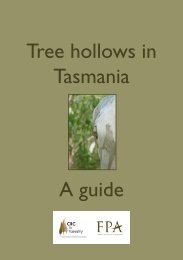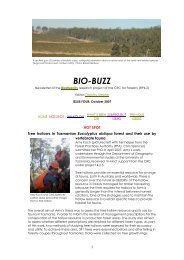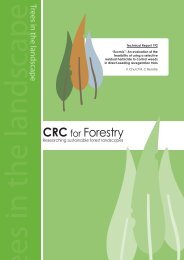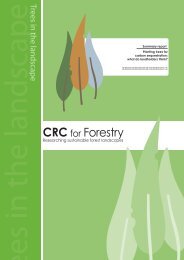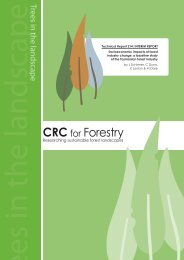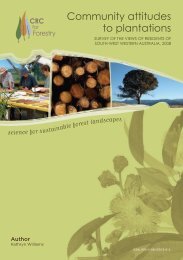CRC Forestry - CRC for Forestry
CRC Forestry - CRC for Forestry
CRC Forestry - CRC for Forestry
You also want an ePaper? Increase the reach of your titles
YUMPU automatically turns print PDFs into web optimized ePapers that Google loves.
issues (Lawson et al., 2008). This may manifest in the recorded common pest species varying over<br />
time. In this study, longer term trends of insect herbivore species show that damage caused by some<br />
species fluctuates, causing problems in some years but rarely consistently every year. Some species<br />
have outbreaks that extend over a few years followed by years of no visible damage. For example,<br />
in Tasmania, scale insects (Eriococcus confusus, E. irregularis) caused locally severe damage in<br />
eucalypt plantations during the mid-1990s but are not recorded in the Tasmanian databases<br />
thereafter. Others caused damage intermittently, interspersed by years with no damage. For<br />
example, in Tasmania, autumn gum moth caused damage in 2002 and then in 2005 but caused little<br />
damage in intervening years (Fig. 4c). Both the chrysomelid beetles, Paropsisterna agricola and<br />
P. bimaculata, and gum leaf skeletoniser also had damage peaks in Tasmania during the mid-2000s<br />
and again around 2009. These fluctuations in pest damage may be caused by several factors.<br />
Interestingly, outbreaks of different species have occurred in different years suggesting that<br />
different species may be responding to different factors (e.g. release from specialist natural<br />
enemies). Changes in the age of trees and a general maturation of the plantation estate may also<br />
explain why the identities of some of the herbivore species have changed over time.<br />
As previously discussed above, interactions with natural enemies and the environment is important.<br />
Many insect herbivores have specialised or generalised natural enemies that often regulate<br />
populations. However, sometimes these natural enemies may become spatially or temporally<br />
isolated, leading to outbreaks of insect herbivores because they are released from their enemies<br />
(e.g. eucalyptus weevil in WA; Loch, 2008). When natural enemies (e.g. predators and diseases)<br />
overcome isolation, they suppress herbivore populations and the insect outbreak diminishes. These<br />
oscillations of populations of natural enemies may be natural or may be mediated by environmental<br />
events (Loch, 2008). The impacts of insect herbivores may be higher during drought years when<br />
trees are stressed and less able to recover from insect herbivory.<br />
3 Have new insect herbivore species recently emerged as pests?<br />
The initial increase in the number of insect herbivore records from E. globulus/nitens plantations at<br />
a national and regional scale over time, in parallel with the increase in the total hardwood estate<br />
size, agree with predictions that the plantation estate should accumulate more herbivore species<br />
(Abbott, 1993b; Loch & Floyd, 2001; Strauss, 2001). Although it is rare to have records of absence<br />
of species, <strong>for</strong>esters in the Green Triangle and WA have noted the ‘honeymoon’ period, during<br />
which no insect has caused damage to trees, in the early years of establishment of plantations in<br />
these regions. The expansion of the plantation estate into ex-agricultural land with embedded<br />
remnants of native vegetation has almost surely led to the successful colonisation of many insect<br />
herbivore species, particularly in areas where the plantation species have been introduced as a new<br />
eucalypt species. Examples of these can be seen in Appendices 1 and 2. Also, in Tasmania, the<br />
introduced species E. nitens now has a higher number of chrysomelids recorded on it than<br />
E. globulus (TFIC database; Lynne Forster, pers. comm.).<br />
Not all insect herbivores colonising eucalypt plantations have originated from native eucalypt<br />
<strong>for</strong>ests. A group of insect herbivores that was not included in the list of predicted species by Strauss<br />
(2001) was nocturnal scarab beetles. Fifty-four species have been recorded in eucalypt plantations<br />
in WA and 46 species in the Green Triangle (Matsuki, 2006a, 2008c). Adults of several species can<br />
be found in large numbers and have caused severe and extensive damage in some years (Matsuki,<br />
2009). Their larvae feed on fine roots and are found predominantly in pastures and degraded<br />
remnants with weeds.<br />
<strong>CRC</strong> <strong>for</strong> <strong>Forestry</strong> Technical Report 216: November 2011<br />
Are insect herbivores in eucalypt plantations a worsening problem? 20




